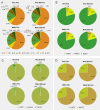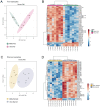Habitat shapes the lipidome of the tropical photosynthetic sea slug Elysia crispata
- PMID: 40417258
- PMCID: PMC12102446
- DOI: 10.1007/s42995-025-00281-1
Habitat shapes the lipidome of the tropical photosynthetic sea slug Elysia crispata
Abstract
Sacoglossan sea slugs have attracted considerable scientific attention due to their capacity to retain functional macroalgal chloroplasts inside their cells. This endosymbiotic association is nutritionally relevant for these organisms and represents an interesting research issue for biotechnological applications. The Caribbean species Elysia crispata can integrate chloroplasts from different macroalgal species. The lipidome of chloroplasts includes lipid classes unique to these photosynthetic organelles. Specialized lipids, such as the glycolipids MGDG, DGDG, and SQDG, are essential for maintaining the integrity of both the thylakoid membranes and the overall chloroplast membrane structure. Additionally, lipids are a diverse group of biomolecules playing essential roles at nutritional and physiological levels. A combined approach using LC-HR-MS and MS/MS was employed to determine the polar lipid profile of the photosynthetic sea slug E. crispata from two habitats in the north-western tropical Atlantic (Sistema Arrecifal Veracruzano and Mahahual) and two different feeding conditions (fed and after 1 week of starvation). Significant differences were identified in the abundance of structural and signalling phospholipids (PC, PI, PG, PS, CL) suggesting different nutritional states between populations. The composition of glycolipids demonstrated a clear separation by habitat, but not by feeding conditions. The lower abundance of glycolipids in the Mahahual samples suggests a lower density of chloroplasts in their tissues compared to Veracruz individuals. These results corroborate that 1 week of starvation is insufficient to initiate the degradation of plastid membranes. This study confirms the advantages of using lipidomics as a tool to enhance our knowledge of the ecology of marine invertebrates.
Supplementary information: The online version contains supplementary material available at 10.1007/s42995-025-00281-1.
Keywords: Kleptoplasty; Lipidomics; Marine invertebrates; Marine lipids; Photosynthetic animals; Polar lipids.
© The Author(s) 2025.
Conflict of interest statement
Conflict of interestThe authors declare that they have no known competing financial interests or personal relationships that could have appeared to influence the work reported in this paper.
Figures







Similar articles
-
Pigment and Fatty Acid Heterogeneity in the Sea Slug Elysia crispata Is Not Shaped by Habitat Depth.Animals (Basel). 2021 Nov 5;11(11):3157. doi: 10.3390/ani11113157. Animals (Basel). 2021. PMID: 34827889 Free PMC article.
-
Prey species and abundance affect growth and photosynthetic performance of the polyphagous sea slug Elysia crispata.R Soc Open Sci. 2023 Aug 30;10(8):230810. doi: 10.1098/rsos.230810. eCollection 2023 Aug. R Soc Open Sci. 2023. PMID: 37650060 Free PMC article.
-
Light modulates the lipidome of the photosynthetic sea slug Elysia timida.Biochim Biophys Acta Mol Cell Biol Lipids. 2023 Feb;1868(2):159249. doi: 10.1016/j.bbalip.2022.159249. Epub 2022 Nov 3. Biochim Biophys Acta Mol Cell Biol Lipids. 2023. PMID: 36336252
-
Role of Lipids in Chloroplast Biogenesis.Subcell Biochem. 2016;86:103-25. doi: 10.1007/978-3-319-25979-6_5. Subcell Biochem. 2016. PMID: 27023233 Review.
-
Photophysiology of kleptoplasts: photosynthetic use of light by chloroplasts living in animal cells.Philos Trans R Soc Lond B Biol Sci. 2014 Mar 3;369(1640):20130242. doi: 10.1098/rstb.2013.0242. Print 2014 Apr 19. Philos Trans R Soc Lond B Biol Sci. 2014. PMID: 24591722 Free PMC article. Review.
References
-
- Bartlett EM, Lewis DH (1970) Spectrophotometric determination of phosphate esters in the presence and absence of orthophosphate. Anal Biochem 36:159–167 - PubMed
-
- Blier PU, Abele D, Munro D, Degletagne C, Rodriguez E, Hagen T (2017) What modulates animal longevity? Fast and slow aging in bivalves as a model for the study of lifespan. Semin Cell Dev Biol 70:130–140 - PubMed
-
- Bligh EG, Dyer WJ (1959) A rapid method of total lipid extraction and purification. Can J Biochem Physiol 37:911–917 - PubMed
-
- Braverman NE, Moser AB (2012) Functions of plasmalogen lipids in health and disease. Biochim Biophys Acta Mol Basis Dis 1822:1442–1452 - PubMed
LinkOut - more resources
Full Text Sources
Research Materials
Miscellaneous

